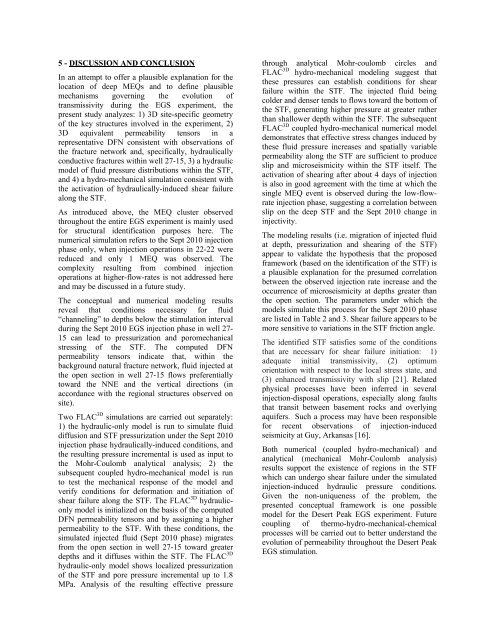computational investigation of hydro-mechanical effects on ...
computational investigation of hydro-mechanical effects on ...
computational investigation of hydro-mechanical effects on ...
You also want an ePaper? Increase the reach of your titles
YUMPU automatically turns print PDFs into web optimized ePapers that Google loves.
5 - DISCUSSION AND CONCLUSION<br />
In an attempt to <str<strong>on</strong>g>of</str<strong>on</strong>g>fer a plausible explanati<strong>on</strong> for the<br />
locati<strong>on</strong> <str<strong>on</strong>g>of</str<strong>on</strong>g> deep MEQs and to define plausible<br />
mechanisms governing the evoluti<strong>on</strong> <str<strong>on</strong>g>of</str<strong>on</strong>g><br />
transmissivity during the EGS experiment, the<br />
present study analyzes: 1) 3D site-specific geometry<br />
<str<strong>on</strong>g>of</str<strong>on</strong>g> the key structures involved in the experiment, 2)<br />
3D equivalent permeability tensors in a<br />
representative DFN c<strong>on</strong>sistent with observati<strong>on</strong>s <str<strong>on</strong>g>of</str<strong>on</strong>g><br />
the fracture network and, specifically, hydraulically<br />
c<strong>on</strong>ductive fractures within well 27-15, 3) a hydraulic<br />
model <str<strong>on</strong>g>of</str<strong>on</strong>g> fluid pressure distributi<strong>on</strong>s within the STF,<br />
and 4) a <str<strong>on</strong>g>hydro</str<strong>on</strong>g>-<str<strong>on</strong>g>mechanical</str<strong>on</strong>g> simulati<strong>on</strong> c<strong>on</strong>sistent with<br />
the activati<strong>on</strong> <str<strong>on</strong>g>of</str<strong>on</strong>g> hydraulically-induced shear failure<br />
al<strong>on</strong>g the STF.<br />
As introduced above, the MEQ cluster observed<br />
throughout the entire EGS experiment is mainly used<br />
for structural identificati<strong>on</strong> purposes here. The<br />
numerical simulati<strong>on</strong> refers to the Sept 2010 injecti<strong>on</strong><br />
phase <strong>on</strong>ly, when injecti<strong>on</strong> operati<strong>on</strong>s in 22-22 were<br />
reduced and <strong>on</strong>ly 1 MEQ was observed. The<br />
complexity resulting from combined injecti<strong>on</strong><br />
operati<strong>on</strong>s at higher-flow-rates is not addressed here<br />
and may be discussed in a future study.<br />
The c<strong>on</strong>ceptual and numerical modeling results<br />
reveal that c<strong>on</strong>diti<strong>on</strong>s necessary for fluid<br />
“channeling” to depths below the stimulati<strong>on</strong> interval<br />
during the Sept 2010 EGS injecti<strong>on</strong> phase in well 27-<br />
15 can lead to pressurizati<strong>on</strong> and poro<str<strong>on</strong>g>mechanical</str<strong>on</strong>g><br />
stressing <str<strong>on</strong>g>of</str<strong>on</strong>g> the STF. The computed DFN<br />
permeability tensors indicate that, within the<br />
background natural fracture network, fluid injected at<br />
the open secti<strong>on</strong> in well 27-15 flows preferentially<br />
toward the NNE and the vertical directi<strong>on</strong>s (in<br />
accordance with the regi<strong>on</strong>al structures observed <strong>on</strong><br />
site).<br />
Two FLAC 3D simulati<strong>on</strong>s are carried out separately:<br />
1) the hydraulic-<strong>on</strong>ly model is run to simulate fluid<br />
diffusi<strong>on</strong> and STF pressurizati<strong>on</strong> under the Sept 2010<br />
injecti<strong>on</strong> phase hydraulically-induced c<strong>on</strong>diti<strong>on</strong>s, and<br />
the resulting pressure incremental is used as input to<br />
the Mohr-Coulomb analytical analysis; 2) the<br />
subsequent coupled <str<strong>on</strong>g>hydro</str<strong>on</strong>g>-<str<strong>on</strong>g>mechanical</str<strong>on</strong>g> model is run<br />
to test the <str<strong>on</strong>g>mechanical</str<strong>on</strong>g> resp<strong>on</strong>se <str<strong>on</strong>g>of</str<strong>on</strong>g> the model and<br />
verify c<strong>on</strong>diti<strong>on</strong>s for deformati<strong>on</strong> and initiati<strong>on</strong> <str<strong>on</strong>g>of</str<strong>on</strong>g><br />
shear failure al<strong>on</strong>g the STF. The FLAC 3D hydraulic<strong>on</strong>ly<br />
model is initialized <strong>on</strong> the basis <str<strong>on</strong>g>of</str<strong>on</strong>g> the computed<br />
DFN permeability tensors and by assigning a higher<br />
permeability to the STF. With these c<strong>on</strong>diti<strong>on</strong>s, the<br />
simulated injected fluid (Sept 2010 phase) migrates<br />
from the open secti<strong>on</strong> in well 27-15 toward greater<br />
depths and it diffuses within the STF. The FLAC 3D<br />
hydraulic-<strong>on</strong>ly model shows localized pressurizati<strong>on</strong><br />
<str<strong>on</strong>g>of</str<strong>on</strong>g> the STF and pore pressure incremental up to 1.8<br />
MPa. Analysis <str<strong>on</strong>g>of</str<strong>on</strong>g> the resulting effective pressure<br />
through analytical Mohr-coulomb circles and<br />
FLAC 3D <str<strong>on</strong>g>hydro</str<strong>on</strong>g>-<str<strong>on</strong>g>mechanical</str<strong>on</strong>g> modeling suggest that<br />
these pressures can establish c<strong>on</strong>diti<strong>on</strong>s for shear<br />
failure within the STF. The injected fluid being<br />
colder and denser tends to flows toward the bottom <str<strong>on</strong>g>of</str<strong>on</strong>g><br />
the STF, generating higher pressure at greater rather<br />
than shallower depth within the STF. The subsequent<br />
FLAC 3D coupled <str<strong>on</strong>g>hydro</str<strong>on</strong>g>-<str<strong>on</strong>g>mechanical</str<strong>on</strong>g> numerical model<br />
dem<strong>on</strong>strates that effective stress changes induced by<br />
these fluid pressure increases and spatially variable<br />
permeability al<strong>on</strong>g the STF are sufficient to produce<br />
slip and microseismicity within the STF itself. The<br />
activati<strong>on</strong> <str<strong>on</strong>g>of</str<strong>on</strong>g> shearing after about 4 days <str<strong>on</strong>g>of</str<strong>on</strong>g> injecti<strong>on</strong><br />
is also in good agreement with the time at which the<br />
single MEQ event is observed during the low-flowrate<br />
injecti<strong>on</strong> phase, suggesting a correlati<strong>on</strong> between<br />
slip <strong>on</strong> the deep STF and the Sept 2010 change in<br />
injectivity.<br />
The modeling results (i.e. migrati<strong>on</strong> <str<strong>on</strong>g>of</str<strong>on</strong>g> injected fluid<br />
at depth, pressurizati<strong>on</strong> and shearing <str<strong>on</strong>g>of</str<strong>on</strong>g> the STF)<br />
appear to validate the hypothesis that the proposed<br />
framework (based <strong>on</strong> the identificati<strong>on</strong> <str<strong>on</strong>g>of</str<strong>on</strong>g> the STF) is<br />
a plausible explanati<strong>on</strong> for the presumed correlati<strong>on</strong><br />
between the observed injecti<strong>on</strong> rate increase and the<br />
occurrence <str<strong>on</strong>g>of</str<strong>on</strong>g> microseismicity at depths greater than<br />
the open secti<strong>on</strong>. The parameters under which the<br />
models simulate this process for the Sept 2010 phase<br />
are listed in Table 2 and 3. Shear failure appears to be<br />
more sensitive to variati<strong>on</strong>s in the STF fricti<strong>on</strong> angle.<br />
The identified STF satisfies some <str<strong>on</strong>g>of</str<strong>on</strong>g> the c<strong>on</strong>diti<strong>on</strong>s<br />
that are necessary for shear failure initiati<strong>on</strong>: 1)<br />
adequate initial transmissivity, (2) optimum<br />
orientati<strong>on</strong> with respect to the local stress state, and<br />
(3) enhanced transmissivity with slip [21]. Related<br />
physical processes have been inferred in several<br />
injecti<strong>on</strong>-disposal operati<strong>on</strong>s, especially al<strong>on</strong>g faults<br />
that transit between basement rocks and overlying<br />
aquifers. Such a process may have been resp<strong>on</strong>sible<br />
for recent observati<strong>on</strong>s <str<strong>on</strong>g>of</str<strong>on</strong>g> injecti<strong>on</strong>-induced<br />
seismicity at Guy, Arkansas [16].<br />
Both numerical (coupled <str<strong>on</strong>g>hydro</str<strong>on</strong>g>-<str<strong>on</strong>g>mechanical</str<strong>on</strong>g>) and<br />
analytical (<str<strong>on</strong>g>mechanical</str<strong>on</strong>g> Mohr-Coulomb analysis)<br />
results support the existence <str<strong>on</strong>g>of</str<strong>on</strong>g> regi<strong>on</strong>s in the STF<br />
which can undergo shear failure under the simulated<br />
injecti<strong>on</strong>-induced hydraulic pressure c<strong>on</strong>diti<strong>on</strong>s.<br />
Given the n<strong>on</strong>-uniqueness <str<strong>on</strong>g>of</str<strong>on</strong>g> the problem, the<br />
presented c<strong>on</strong>ceptual framework is <strong>on</strong>e possible<br />
model for the Desert Peak EGS experiment. Future<br />
coupling <str<strong>on</strong>g>of</str<strong>on</strong>g> thermo-<str<strong>on</strong>g>hydro</str<strong>on</strong>g>-<str<strong>on</strong>g>mechanical</str<strong>on</strong>g>-chemical<br />
processes will be carried out to better understand the<br />
evoluti<strong>on</strong> <str<strong>on</strong>g>of</str<strong>on</strong>g> permeability throughout the Desert Peak<br />
EGS stimulati<strong>on</strong>.
















